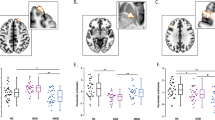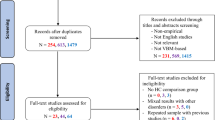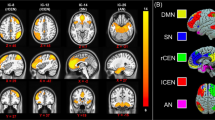Abstract
Depressive symptoms are common in multiple psychiatric disorders and are frequent sequelae of trauma. A dimensional conceptualization of depression suggests that symptoms should be associated with a continuum of deficits in specific neural circuits. However, most prior investigations of abnormalities in functional connectivity have typically focused on a single diagnostic category using hypothesis-driven seed-based analyses. Here, using a sample of 105 adult female participants from three diagnostic groups (healthy controls, n=17; major depression, n=38; and post-traumatic stress disorder, n=50), we examine the dimensional relationship between resting-state functional dysconnectivity and severity of depressive symptoms across diagnostic categories using a data-driven analysis (multivariate distance-based matrix regression). This connectome-wide analysis identified foci of dysconnectivity associated with depression severity in the bilateral amygdala. Follow-up seed analyses using subject-specific amygdala segmentations revealed that depression severity was associated with amygdalo-frontal hypo-connectivity in a network of regions including bilateral dorsolateral prefrontal cortex, anterior cingulate and anterior insula. In contrast, anxiety was associated with elevated connectivity between the amygdala and the ventromedial prefrontal cortex. Taken together, these results emphasize the centrality of the amygdala in the pathophysiology of depressive symptoms, and suggest that dissociable patterns of amygdalo-frontal dysconnectivity are a critical neurobiological feature across clinical diagnostic categories.
This is a preview of subscription content, access via your institution
Access options
Subscribe to this journal
Receive 12 print issues and online access
$259.00 per year
only $21.58 per issue
Buy this article
- Purchase on Springer Link
- Instant access to full article PDF
Prices may be subject to local taxes which are calculated during checkout




Similar content being viewed by others
References
Kessler RC, Wang PS . The descriptive epidemiology of commonly occurring mental disorders in the united states. Annu Rev Public Health 2008; 29: 115–129.
Insel T, Cuthbert B, Garvey M, Heinssen R, Pine DS, Quinn K et al. Research domain criteria (rdoc): toward a new classification framework for research on mental disorders. Am J Psychiatry 2010; 167: 748–751.
Kessler RC, Sonnega A, Bromet E, Hughes M, Nelson CB . Posttraumatic stress disorder in the national comorbidity survey. Arch Gen Psychiatry 1995; 52: 1048–1060.
Kessler RC . Posttraumatic stress disorder: The burden to the individual and to society. J Clin Psychiatry 2000; 61: 4–12.
Kessler RC, Berglund P, Demler O, Jin R, Koretz D, Merikangas KR et al. The epidemiology of major depressive disorder: results from the national comorbidity survey replication (NCS-R). JAMA 2003; 289: 3095–3105.
Zlotnick C, Rodriguez BF, Weisberg RB, Bruce SE, Spencer MA, Culpepper L et al. Chronicity in posttraumatic stress disorder and predictors of the course of posttraumatic stress disorder among primary care patients. J Nerv Ment Dis 2004; 192: 153–159.
Kessler RC, Berglund P, Demler O, Jin R, Merikangas KR, Walters EE . Lifetime prevalence and age-of-onset distributions of DSM-IV disorders in the national comorbidity survey replication. Arch Gen Psychiatry 2005; 62: 593–602.
Oathes DJ, Patenaude B, Schatzberg AF, Etkin A . Neurobiological signatures of anxiety and depression in resting-state functional magnetic resonance imaging. Biol Psychiatry 2015; 77: 385–393.
Dichter GS, Gibbs D, Smoski MJ . A systematic review of relations between resting-state functional-mri and treatment response in major depressive disorder. J Affect Disord 2014; 172C: 8–17.
Pitman RK, Rasmusson AM, Koenen KC, Shin LM, Orr SP, Gilbertson MW et al. Biological studies of post-traumatic stress disorder. Nat Rev Neurosci 2012; 13: 769–787.
Goodkind M, Eickhoff SB, Oathes DJ, Jiang Y, Chang A, Jones-Hagata LB et al. Identification of a common neurobiological substrate for mental illness. JAMA Psychiatry 2015; 72: 305–315.
Elhai JD, Grubaugh AL, Kashdan TB, Frueh BC . Empirical examination of a proposed refinement to DSM-IV posttraumatic stress disorder symptom criteria using the national comorbidity survey replication data. J Clin Psychiatry 2008; 69: 597–602.
Brown TA, Campbell LA, Lehman CL, Grisham JR, Mancill RB . Current and lifetime comorbidity of the DSM-IV anxiety and mood disorders in a large clinical sample. J Abnorm Psychol 2001; 110: 585–599.
Keane TM, Kaloupek DG . Comorbid psychiatric disorders in PTSD. Implications for research. Ann N Y Acad Sci 1997; 821: 24–34.
Grant DM, Beck JG, Marques L, Palyo SA, Clapp JD . The structure of distress following trauma: posttraumatic stress disorder, major depressive disorder, and generalized anxiety disorder. J Abnorm Psychol 2008; 117: 662–672.
Ford JD, Elhai JD, Ruggiero KJ, Frueh BC . Refining posttraumatic stress disorder diagnosis: evaluation of symptom criteria with the national survey of adolescents. J Clin Psychiatry 2009; 70: 748–755.
Watson D, Naragon-Gainey K . On the specificity of positive emotional dysfunction in psychopathology: evidence from the mood and anxiety disorders and schizophrenia/schizotypy. Clin Psychol Rev. 2009; 30: 839–848.
Biswal B, Yetkin FZ, Haughton VM, Hyde JS . Functional connectivity in the motor cortex of resting human brain using echo-planar MRI. Magn Reson Med 1995; 34: 537–541.
Lanius RA, Bluhm RL, Coupland NJ, Hegadoren KM, Rowe B, Théberge J et al. Default mode network connectivity as a predictor of post-traumatic stress disorder symptom severity in acutely traumatized subjects. Acta Psychiatr Scand. 2010; 121: 33–40.
Fonzo GA, Simmons AN, Thorp SR, Norman SB, Paulus MP, Stein MB . Exaggerated and disconnected insular-amygdalar blood oxygenation level-dependent response to threat-related emotional faces in women with intimate-partner violence posttraumatic stress disorder. Biol Psychiatry 2010; 68: 433–441.
Matthews SC, Strigo IA, Simmons AN, Yang TT, Paulus MP . Decreased functional coupling of the amygdala and supragenual cingulate is related to increased depression in unmedicated individuals with current major depressive disorder. J Affect Disord 2008; 111: 13–20.
Johnstone T, van Reekum CM, Urry HL, Kalin NH, Davidson RJ . Failure to regulate: counterproductive recruitment of top-down prefrontal-subcortical circuitry in major depression. J Neurosci 2007; 27: 8877–8884.
Brown VM, LaBar KS, Haswell CC, Gold AL, McCarthy G, Morey RA . Altered resting-state functional connectivity of basolateral and centromedial amygdala complexes in posttraumatic stress disorder. Neuropsychopharmacology 2014; 39: 351–359.
Bryant RA, Kemp AH, Felmingham KL, Liddell B, Olivieri G, Peduto A et al. Enhanced amygdala and medial prefrontal activation during nonconscious processing of fear in posttraumatic stress disorder: an fmri study. Hum Brain Mapp 2008; 29: 517–523.
McCabe C, Mishor Z . Antidepressant medications reduce subcortical-cortical resting-state functional connectivity in healthy volunteers. Neuroimage 2011; 57: 1317–1323.
Veer IM, Oei NYL, Spinhoven P, van Buchem MA, Elzinga BM . Rombouts SARB. Beyond acute social stress: increased functional connectivity between amygdala and cortical midline structures. Neuroimage 2011; 57: 1534–1541.
Koenigs M, Grafman J . The functional neuroanatomy of depression: distinct roles for ventromedial and dorsolateral prefrontal cortex. Behav Brain Res 2009; 201: 239–243.
Zhu X, Wang X, Xiao J, Liao J, Zhong M, Wang W et al. Evidence of a dissociation pattern in resting-state default mode network connectivity in first-episode, treatment-naive major depression patients. Biol Psychiatry 2012; 71: 611–617.
Zhang J, Wang J, Wu Q, Kuang W, Huang X, He Y et al. Disrupted brain connectivity networks in drug-naive, first-episode major depressive disorder. Biol Psychiatry 2011; 70: 334–342.
Erk S, Mikschl A, Stier S, Ciaramidaro A, Gapp V, Weber B et al. Acute and sustained effects of cognitive emotion regulation in major depression. J Neurosci 2010; 30: 15726–15734.
Wang L, Hermens DF, Hickie IB, Lagopoulos J . A systematic review of resting-state functional-mri studies in major depression. J Affect Disord 2012; 142: 6–12.
Shehzad Z, Kelly C, Reiss PT, Cameron Craddock R, Emerson JW, McMahon K et al. A multivariate distance-based analytic framework for connectome-wide association studies. Neuroimage 2014; 93: 74–94.
First MB, Spitzer RL, Gibbon M, Williams JBW . Structured Clinical Interview for DSM-IV Axis I Disorders, patient edition (SCID-P), version 2. New York, New York State Psychiatric Institute: Biometrics Research, 1996.
Blake DD, Weathers FW, Nagy LM, Kaloupek DG, Gusman FD, Charney DS et al. The development of a clinician-administered PTSD scale. J Trauma Stress 1995; 8: 75–90.
Montgomery SA, Asberg M . A new depression scale designed to be sensitive to change. Br J Psychiatry 1979; 134: 382.
Spielberger CD, Gorsuch RL, Lushene RE (eds). Manual for the state-trait anxiety inventory Manual for the State-trait Anxiety Inventory 1970.
Satterthwaite TD, Wolf DH, Ruparel K, Erus G, Elliott MA, Eickhoff SB et al. Heterogeneous impact of motion on fundamental patterns of developmental changes in functional connectivity during youth. Neuroimage 2013; 83: 45–57.
Avants BB, Tustison NJ, Song G, Cook PA, Klein A, Gee JC . A reproducible evaluation of ants similarity metric performance in brain image registration. Neuroimage 2011; 54: 2033–2044.
Klein A, Andersson J, Ardekani BA, Ashburner J, Avants B, Chiang M-C et al. Evaluation of 14 nonlinear deformation algorithms applied to human brain MRI registration. Neuroimage 2009; 46: 786–802.
Tustison NJ, Cook PA, Klein A, Song G, Das SR, Duda JT et al. Large-scale evaluation of ants and freesurfer cortical thickness measurements. Neuroimage 2014; 99: 166–179.
Tustison NJ, Avants BB, Cook PA, Zheng Y, Egan A, Yushkevich PA et al. N4ITK: improved N3 bias correction. IEEE Trans Med Imaging 2010; 29: 1310–1320.
Avants BB, Tustison NJ, Wu J, Cook PA, Gee JC . An open source multivariate framework for n-tissue segmentation with evaluation on public data. Neuroinformatics 2011; 9: 381–400.
Satterthwaite TD, Elliott MA, Gerraty RT, Ruparel K, Loughead J, Calkins ME et al. An improved framework for confound regression and filtering for control of motion artifact in the preprocessing of resting-state functional connectivity data. Neuroimage 2013; 64: 240–256.
Jenkinson M, Bannister P, Brady M, Smith S . Improved optimization for the robust and accurate linear registration and motion correction of brain images. Neuroimage 2002; 17: 825–841.
Hallquist MN, Hwang K, Luna B . The nuisance of nuisance regression: spectral misspecification in a common approach to resting-state fmri preprocessing reintroduces noise and obscures functional connectivity. Neuroimage 2013; 82C: 208–225.
Greve DN, Fischl B . Accurate and robust brain image alignment using boundary-based registration. Neuroimage 2009; 48: 63–72.
Reiss PT, Stevens MHH, Shehzad Z, Petkova E, Milham MP . On distance-based permutation tests for between-group comparisons. Biometrics 2010; 66: 636–643.
Cox RW . AFNI: software for analysis and visualization of functional magnetic resonance neuroimages. Comput Biomed Res 1996; 29: 162–173.
Wang H, Suh JW, Das SR, Pluta J, Craige C, Yushkevich PA . Multi-Atlas segmentation with joint label fusion. IEEE Trans Pattern Anal Mach Intell 2013; 35: 611–623.
Van Essen DC, Drury HA, Dickson J, Harwell J, Hanlon D, Anderson CH . An integrated software suite for surface-based analyses of cerebral cortex. J Am Med Inform Assoc 2001; 8: 443–459.
Sacher J, Neumann J, Fünfstück T, Soliman A, Villringer A, Schroeter ML . Mapping the depressed brain: a meta-analysis of structural and functional alterations in major depressive disorder. J Affect Disord 2012; 140: 142–148.
Liberzon I, Sripada CS . The functional neuroanatomy of PTSD: a critical review. Prog Brain Res 2008; 167: 151–169.
Etkin A, Wager TD . Functional neuroimaging of anxiety: a meta-analysis of emotional processing in PTSD, social anxiety disorder, and specific phobia. Am J Psychiatry 2007; 164: 1476–1488.
Hayes JP, Hayes SM, Mikedis AM . Quantitative meta-analysis of neural activity in posttraumatic stress disorder. Biol Mood Anxiety Disord 2012; 2: 9.
Rauch SL, Whalen PJ, Shin LM, McInerney SC, Macklin ML, Lasko NB et al. Exaggerated amygdala response to masked facial stimuli in posttraumatic stress disorder: a functional MRI study. Biol Psychiatry 2000; 47: 769–776.
Sheline YI, Barch DM, Donnelly JM, Ollinger JM, Snyder AZ, Mintun MA . Increased amygdala response to masked emotional faces in depressed subjects resolves with antidepressant treatment: an fmri study. Biol Psychiatry 2001; 50: 651–658.
Yang TT, Simmons AN, Matthews SC, Tapert SF, Frank GK, Max JE et al. Adolescents with major depression demonstrate increased amygdala activation. J Am Acad Child Adolesc Psychiatry 2010; 49: 42–51.
Dosenbach NUF, Fair DA, Miezin FM, Cohen AL, Wenger KK, Dosenbach RAT et al. Distinct brain networks for adaptive and stable task control in humans. Proc Natl Acad Sci USA 2007; 104: 11073–11078.
Yeo BTT, Krienen FM, Sepulcre J, Sabuncu MR, Lashkari D, Hollinshead M et al. The organization of the human cerebral cortex estimated by intrinsic functional connectivity. J Neurophysiol 2011; 106: 1125–1165.
Buckner RL, Andrews-Hanna JR, Schacter DL . The brain's default network: anatomy, function, and relevance to disease. Ann N Y Acad Sci 2008; 1124: 1–38.
Sheline YI, Barch DM, Price JL, Rundle MM, Vaishnavi SN, Snyder AZ et al. The default mode network and self-referential processes in depression. Proc Natl Acad Sci USA 2009; 106: 1942–1947.
Sheline YI, Price JL, Yan Z, Mintun MA . Resting-state functional MRI in depression unmasks increased connectivity between networks via the dorsal nexus. Proc Natl Acad Sci USA 2010; 107: 11020–11025.
Hamilton JP, Farmer M, Fogelman P, Gotlib IH . Depressive rumination, the default-mode network, and the dark matter of clinical neuroscience. Biol Psychiatry 2015; 78: 224–230.
Mayberg HS, Lozano AM, Voon V, McNeely HE, Seminowicz D, Hamani C et al. Deep brain stimulation for treatment-resistant depression. Neuron 2005; 45: 651–660.
Kim MJ, Gee DG, Loucks RA, Davis FC, Whalen PJ . Anxiety dissociates dorsal and ventral medial prefrontal cortex functional connectivity with the amygdala at rest. Cereb Cortex 2011; 21: 1667–1673.
Rabinak CA, Angstadt M, Welsh RC, Kenndy AE, Lyubkin M, Martis B et al. Altered amygdala resting-state functional connectivity in post-traumatic stress disorder. Front Psychiatry 2011; 2: 62.
Zhou Y, Wang Z, Qin L-D, Wan J-Q, Sun Y-W, Su S-S et al. Early altered resting-state functional connectivity predicts the severity of post-traumatic stress disorder symptoms in acutely traumatized subjects. PLoS One 2012; 7: e46833.
Kim MJ, Loucks RA, Palmer AL, Brown AC, Solomon KM, Marchante AN et al. The structural and functional connectivity of the amygdala: from normal emotion to pathological anxiety. Behav Brain Res 2011; 223: 403–410.
Satterthwaite TD, Kable JW, Vandekar L, Katchmar N, Bassett DS, Baldassano CF et al. Common and dissociable dysfunction of the reward system in bipolar and unipolar depression reward dysfunction in depression. Neuropsychopharmacology 2015; 40: 2258–2268.
Sanislow CA, Pine DS, Quinn KJ, Kozak MJ, Garvey MA, Heinssen RK et al. Developing constructs for psychopathology research: research domain criteria. J Abnorm Psychol 2010; 119: 631–639.
Cuthbert BN . The rdoc framework: facilitating transition from ICD/DSM to dimensional approaches that integrate neuroscience and psychopathology. World Psychiatry 2014; 13: 28–35.
Chen AC, Oathes DJ, Chang C, Bradley T, Zhou Z-W, Williams LM et al. Causal interactions between fronto-parietal central executive and default-mode networks in humans. Proc Natl Acad Sci USA 2013; 110: 19944–19949.
Fox MD, Liu H, Pascual-Leone A . Identification of reproducible individualized targets for treatment of depression with TMS based on intrinsic connectivity. Neuroimage 2013; 66: 151–160.
Author information
Authors and Affiliations
Corresponding author
Ethics declarations
Competing interests
CC was previously on the speaker’s bureau for Bristol-Myers Squibb and Otsuka Pharmaceuticals and has received research funding from Bristol-Myers Squibb, Cyberonics, the Stanley Baer Foundation, the Brain and Behavior Research Foundation and the Taylor Foundation for Innovative Psychiatric Research. He serves as a non-paid consultant to Cyberonics. Remaining authors declare no conflict of interest.
Additional information
Supplementary Information accompanies the paper on the Molecular Psychiatry website
Rights and permissions
About this article
Cite this article
Satterthwaite, T., Cook, P., Bruce, S. et al. Dimensional depression severity in women with major depression and post-traumatic stress disorder correlates with fronto-amygdalar hypoconnectivty. Mol Psychiatry 21, 894–902 (2016). https://doi.org/10.1038/mp.2015.149
Received:
Revised:
Accepted:
Published:
Issue Date:
DOI: https://doi.org/10.1038/mp.2015.149
This article is cited by
-
A coordinate-based meta-analysis of human amygdala connectivity alterations related to early life adversities
Scientific Reports (2023)
-
Prefrontal cortex interactions with the amygdala in primates
Neuropsychopharmacology (2022)
-
Novel polygenic risk score as a translational tool linking depression-related changes in the corticolimbic transcriptome with neural face processing and anhedonic symptoms
Translational Psychiatry (2020)
-
Applying dimensional psychopathology: transdiagnostic associations among regional homogeneity, leptin and depressive symptoms
Translational Psychiatry (2020)
-
Lower synaptic density is associated with depression severity and network alterations
Nature Communications (2019)



